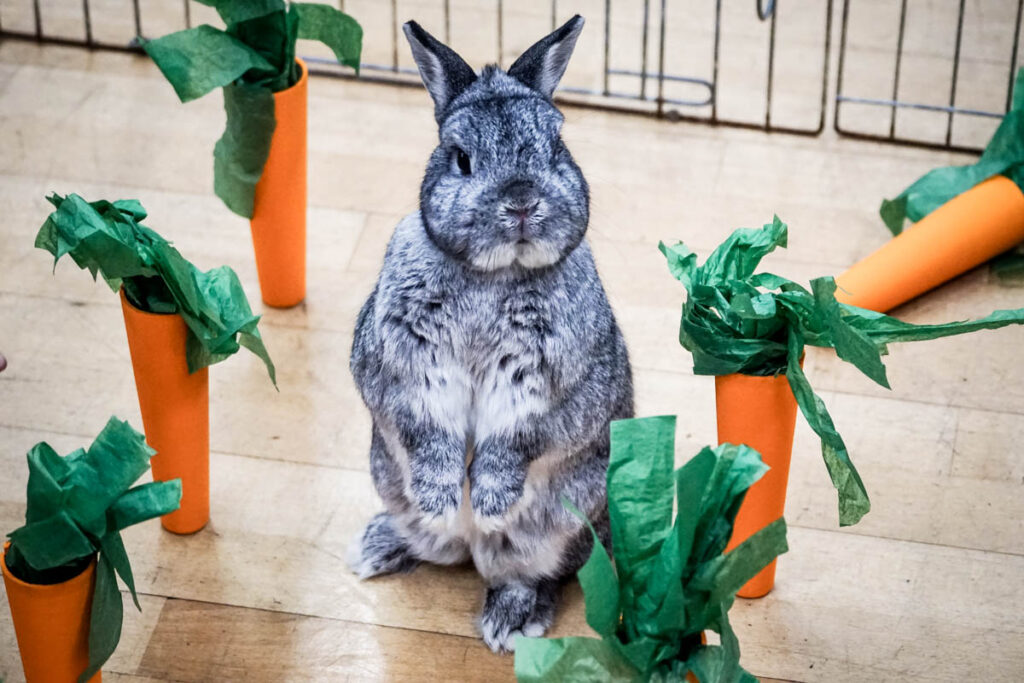Training your rabbit can be an incredibly rewarding journey filled with understanding and companionship. It’s important to begin with a solid understanding of communication basics and the role of positive rewards and feedback.
the Foundations of Positive Training
Rabbits ARE Companions
Instead of the traditional concept of “ownership,” embrace the idea of rabbits as companions. Your bunny shares your home and is a part of your family. Consciously interact with your rabbit as a companion, creating a mutually beneficial relationship.
You ARE A Caretaker
Embrace the role of a caretaker with love and responsibility. As a human companion, accepting responsibility for your animal friends means understanding their unique needs and abilities and fostering a connection that goes beyond mere ownership. As rabbit educator Nancy LaRoche said in a seminal training article, “The scope of that [caregiving] responsibility is based on the relative abilities and needs of each, especially in those areas where breeding and human control have taken the ability of independent survival from a species.”
COmmunication & Respect ARe the Foundation
Respect forms the foundation of your bond. Acknowledge that companions, regardless of species, have the right to be themselves. Make decisions considering their well-being, understanding that coercion has no place in a respectful relationship. It’s helpful to view training as an enriching communication activity that fosters understanding between you and your rabbit companions.
Start with A Solid Home Base
Rabbits should have a spacious enclosure/pen within the family home, complete with a litter box, food dishes, toys, and abundant room for them to stretch fully in all directions. Ideally, include a shelf, loft, or other enrichment for vertical exploration.
Time and Patience Will Pay off
Commit to a daily minimum of 30 minutes of focused training, but don’t push for multiple hours. Limiting your rabbit’s training to when you can closely monitor them and restrict their access to a defined indoor space. You can gradually expand their boundaries as your bunny becomes well-trained within this confined area.
You Still Need To Bunny- Proof
Don’t rely solely on training to stop a rabbit from accessing potentially harmful or life-threatening items. Ensure that toxic house plants and electrical wires are completely out of reach for your rabbit. Depending on training or assuming past behavior patterns in such situations is risky and could lead to a tragic accident.
Rabbit Behavior Basics
Training rabbits becomes easier when you understand that your bunny’s behavior stems from one of three basic bunny truths
- Rabbits have aninstinctive need to chew and dig.
- Rabbits communicate nonverbally.
- Rabbits perceive social structure through a pecking (or nipping) order, influencing their interactions with all family members.
Age Considerations
Young rabbits have more energy, a strong urge to explore, and require less training compared to older rabbits. Similar to puppies, young bunnies have a penchant for chewing. While older rabbits may still enjoy chewing, it tends to be less intense than when they were young. Rabbits chew to naturally wear down their continuously growing teeth. However, they also chew non-food items as a means of exploring the world through taste and texture, building strong jaw muscles, and for the sheer enjoyment of it. Older rabbits may chew less as they become familiar with the world and rely more on food for dental maintenance.
Chewing and Digging Solutions
During training sessions, focus exclusively on the rabbit. Allow her (or them) to come out of their enclosure at their own pace. You can offer toys or treats by hand but refrain from interfering if she wants to explore. Keep a close eye on the rabbit during this time.
If the rabbit begins to chew on undesirable items, immediately provide alternative, acceptable items to chew on and block access to the tempting item securely to prevent further interest.
When possible, offer alternatives with a similar or better taste and texture. For instance, use a piece of untreated, fixed baseboard instead of the real baseboard or scrap carpet instead of the actual carpet (as long as the rabbit doesn’t ingest it). An apple branch can substitute for chair legs.
The same principle applies to digging behavior. If the rabbit enjoys digging in the carpet, create a designated digging area, like a small corner or tunnel with replaceable carpeting at the bottom. Alternatively, fashion a digging box by blocking one end of a covered litter box and cutting a hole in the side. The rabbit will enter, align her body lengthwise (provided she isn’t too large), and the digging material will stay contained against the sealed end of the litter box. Ensure the digging material is entirely dust-free and safe (refer to the litter FAQ). Rabbits, with their remarkable intelligence, quickly adapt to such training.
Non-verbal Communication
Rabbits communicate with humans without words, and one clear example of this is their response when being picked up. Their struggle during this moment is a clear message, essentially saying, “I don’t like being picked up! Please put me down! I don’t feel safe when you take control of my body this way!” There are very few situations where it’s appropriate for humans to impose their will on a companion animal in such a manner. Of course, there are instances, like when a rabbit’s teeth need examination or clipping due to malocclusion, where it may be necessary to hold them against their will. However, it is unacceptable for humans to impose their desires on animals of another species just to fulfill their own wishes.
If you want your rabbit to enjoy sitting on your lap and being stroked, build trust by never forcibly grabbing or holding them against their will when they come to you. Instead, use positive reinforcement methods like treats, gentle nose-to-nose touching, chin-rubbing (placing your chin on the rabbit’s face), or gentle ear rubbing—whatever the rabbit enjoys—to encourage their pleasure in your company. And if your rabbit doesn’t happen to enjoy these activities, respect and appreciate them for who they are. Just as you desire understanding and respect, extend the same courtesy to your furry friend.
A rabbit that enjoys being on your lap and being stroked may gently nip you if you become distracted and stop petting them. This isn’t an attempt to harm you but rather a way of reminding you to continue what you were doing. When a rabbit nips in such a context (appropriately, for communication purposes), they may not realize how painful it is or the severity of the resulting bruise. In such cases, emit a high-pitched, sudden, and loud screech to convey that the nip hurt you. This squeal should startle the rabbit slightly. With consistent feedback, the next time they nip (appropriately), you’ll notice a considerable reduction in force. Continue to squeal when nipped, until the nip is gentle enough to cause no pain or bruising. Applying ice promptly to the bruise will help.
Social Structure Dynamics
Finally, let’s address behavior driven by a rabbit’s natural desire to establish dominance, which is distinct from the previously discussed behaviors like chewing, digging, litter training, or nipping. Keep in mind that your ultimate objective is to convince your rabbit that you are the top-rabbit in your relationship. This doesn’t involve forcing your will upon them in a way that neglects their needs and desires. Instead, it’s a crucial aspect of establishing a healthy companion-companion relationship that meets both your and your rabbit’s needs (they will happily accept you as the natural dominant figure).
For example, if a rabbit jumps onto the couch where you’re seated and deliberately nips you, she’s likely attempting to claim the couch for herself (referred to as “inappropriate nipping”). In response, emit a sharp “No!” while gently returning her to the floor. If she jumps back up without nipping, she’s learning to share the space without challenging your presence. However, if she nips again upon returning, repeat the screech, “No!” and return her to the floor. If she attempts a third time with a nip, it’s time for her to have a brief “time-out” in her enclosure for about two minutes. If she protests in her enclosure by shaking the “bars” and acting out, ignore her. Once she’s calm, she can come out. If she persists in trying to displace you from your seat, she may need to remain in her enclosure until the next scheduled time for her to be let out. This same approach applies whenever a rabbit tries to assert dominance. Your rabbit will be happier when they understand that humans are the top-rabbits.
Another related behavior is when a rabbit urinates on furniture where you often sit or on your bed, akin to one rabbit urinating in another’s cage to assert dominance. The response from the human companion is important here. While you can control access to your bedroom, restricting access to a shared family room with furniture may be more challenging.
While some people may choose to use something like a Snappy Trainer, I prefer to place a pen around the disputed territory (aka the bed) when I am not present. I only allow the rabbit access to the area in question when I am physically present to complete the feedback loop.
Final Thoughts
Training your rabbit is a rewarding journey that requires your time, dedication, and creativity. It’s about being curious; understanding their likes and dislikes, finding ways to provide enjoyable experiences, and keeping their world exciting with new toys and activities.
Embrace the joy of having rabbit companions! Take a holistic approach to creating a bond with your bunny, going beyond mere commands. Train them with care, shower them with love and attention, and celebrate their unique personalities. You’ll both cherish the bond you share, filled with harmony, happiness, and companionship.
The author would like to thank Nancy LaRoche for her FAQ on training rabbits, which motivated this article.

